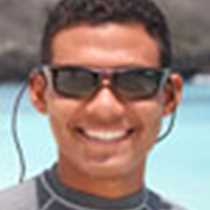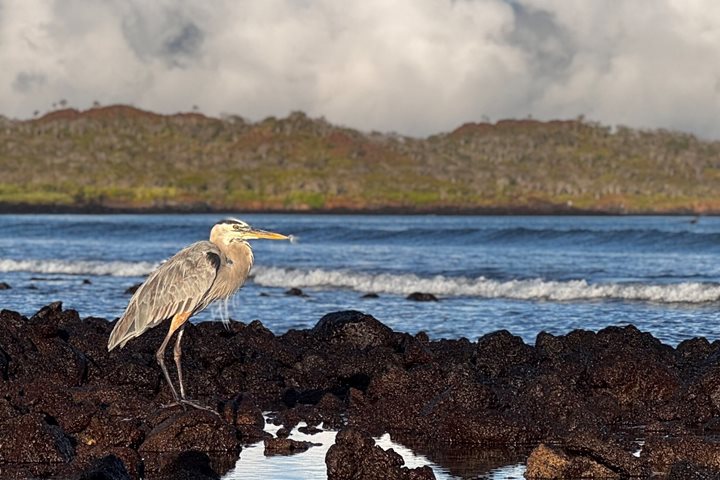It is 6:00 a.m. and the National Geographic Endeavor prepares to enter the collapsed caldera of Genovesa Island, as the sun pokes through the clouds above the horizon, we observe at the distance what appears to be thousands of swallow-like birds flying in and out of the cliffs. The ship drops anchors in the northeastern side of the caldera and we observe our first flock of red footed boobies and great frigate flying above the deck in the blue sky, promising an extraordinary expedition ahead of us.
We start the morning activities right after breakfast, a zodiac ride takes us to the cliff side of the caldera on our way to “Prince Philip’s Steps” our visit for this morning. Along the way we encounter several seabirds perched on the lava rocks and the Galapagos fur seals in the water as if they were practicing synchronized swimming. After a 90-foot climb to the top of the cliff our guests were able to observe what appeared to be a recent Nazca booby hatchling being taken care of by one of the parents and as we look around us we realized we were surrounded by hundreds if not thousands of frigate birds, red footed boobies and Nazca boobies. What a great welcome committee to such place, a true bird paradise, as we walk through the dry forest several Darwin finches, Galapagos mocking birds and Galapagos doves appear on the trail picking up some of the lasts seeds of the past rainy season and show no fear as we pass as if we would not be even there. We advance to the other side of the point where the youngest part of the island serves as natural habitat to one of the largest colonies of storm petrels in the world; we get our binoculars out and start our search for one of the rarest predator of the Galapagos “The Short Eared Owl”.
We walk along an eroded lava flow looking for small crevices where we potentially could find storm petrels nesting and of course the top predator of the island, one of our guest spots at the distance in a tiny lava tube a short-eared owl waiting patiently for possible petrels to land and then somebody screams at the distance “ooowwwl”, another group of guest spotted another one hiding in a small piece of grass a few feet from our guests cameras as if it were posing for us. What an incredible experience at Prince Philip’s Steps but it is time to return to the ship so we continue with the water activities kayaking and snorkel.
As if the morning couldn’t get any better, the snorkelers return with happy faces after having snorkeled with one of the most sought after species by avid scuba divers “The scalloped hammer-head shark” and a large school of golden rays, a great way to finish the water activities of the expedition.
In the afternoon we have a wet landing on a white coralline beach at Darwin Bay in the north side of the caldera, as our guests prepare to start the visit; several swallow-tailed gulls fly over our heads and land next to us as if we were part of their habitat. The walk takes us to a patch of red mangrove that serves as a home for a large group of red-footed boobies; we then observe some very young chicks being fed by their parents and several other adults building their nests among the network of branches of the mangrove. As we walk further along the coast line we notice a lot of contrast of colors; many male frigate birds with pouches against the green bushes expecting to be selected by the female frigate birds flying overhead, an environment full of colors and sounds since many mating calls can be heard.
A great site for photography as the sun comes closer to the horizon it seems as though the island is bathed in a golden color. All our guests come back from a world class visit ready to share memories and incredible moments lived in our little world the Galapagos.









